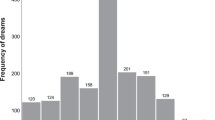Abstract
Prior studies indicate that a personality dimension reflecting thin versus thick boundaries is related to global ratings of dream vividness, amount of emotion, and amount of interaction. In the present study, these relationships were examined by relating scores from the Boundary Questionnaire ( Hartmann, 1991) to dream content among 80 patients seen at a sleep disorders center. Thinness of boundaries was significantly correlated with dream length, vividness, amount of detail, and amount of emotion, and showed a trend towards correlation with aggressive interaction and nightmare-likeness. When dream length was statistically controlled, the relationships between boundary structure and dream content were no longer statistically significant, although amount of emotion and amount of detail showed a trend in the original direction. A principal components analysis was used to identify three factors in the dream content data (eigenvalues > 1.0). The first factor involved dream length, vividness, detail, and emotion; the second involved love/tender interaction and sexual interaction; and the third involved aggressive interaction. Thinness of boundaries showed a significant correlation with only the first factor. We suggest that the trait continuum ranging from thick to thin boundaries is similar to the state continuum running from focused waking thought to dreaming, and that both continua refer to the same aspects of cortical activity.
Similar content being viewed by others
REFERENCES
Ehrman, M. (1993). Ego boundaries revisited: Toward a model of personality and learning. In J. E. Alatis (Ed.), Strategic Interaction and Language Acquisition: Theory, Practice, and Research. Washington, D.C.: Georgetown University Press.
Foulkes, D. (1966). The Psychology of Sleep. New York: Scribners.
Hartmann, E. (1989). Boundaries of dreams; boundaries of dreamers: Thin and thick boundaries as a new personality dimension. Psychiatric Journal of the University of Ottawa, 14, 557–560.
Hartmann, E. (1990). Non-dreamers have “thick boundaries”; good dream-recallers “thin boundaries”. Sleep Research, 19, 135.
Hartmann, E. (1991). Boundaries in the Mind: A New Psychology of Personality. New York: Basic Books.
Hartmann, E. (1996). We do not dream of the Three “R”s. Sleep Research, 25, 136.
Hartmann, E., Skoff, B., Russ, D., & Oldfield, M. (1978). The biochemistry of the nightmare: possible involvement of dopamine. Sleep Research, 7, 186.
Hartmann, E., Russ, D., Oldfield, M., Falke, R., & Skoff, B. (1980). Dream content: Effects of 1-DOPA. Sleep Research, 9, 153.
Hartmann, E., Elkin, R., & Garg, M. (1991). Personality and dreaming: The dreams of people with very thick or very thin boundaries. Dreaming, 1, 311–324.
Hauri, P., Sawyer, J., & Rechtschaffen, A. (1967). Dimensions of dreaming: A factored scale for rating dream reports. Journal of Abnormal Psychology, 72, 16–22.
Kunzendorf, R. G., Hartmann, E., Cohen, R., & Cutler, J. (1997). Bizarreness of the dreams and daydreams reported by individuals with thin and thick boundaries. Dreaming, 7, 265–271.
McCrae, R. R. (1994). Openness to experience: Expanding the boundaries of Factor V. European Journal of Personality, 8, 251–272.
Schredl, M., Kleinferchner, P., & Gell, T. (1996). Dreaming and personality: Thick vs. thin boundaries. Dreaming, 6, 219–223.
Author information
Authors and Affiliations
Rights and permissions
About this article
Cite this article
Hartmann, E., Rosen, R. & Rand, W. Personality and Dreaming: Boundary Structure and Dream Content. Dreaming 8, 31–39 (1998). https://doi.org/10.1023/B:DREM.0000005913.21794.1f
Issue Date:
DOI: https://doi.org/10.1023/B:DREM.0000005913.21794.1f




